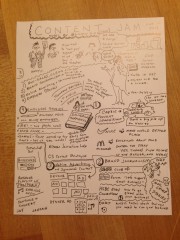Today begins a week-long look at Content Jam, starting with my keynote and ending on Thursday with analytics. Each post will run at noon CT this week and is written by a member of our team. So uncap your highlighters, open your moleskins, and get ready to take some notes.
A couple of weeks ago, I had the sheer pleasure to keynote Content Jam, a conference about, well, content, put on by Orbit Media, StoryStudio, and Mightybytes.
My topic? The future of content marketing.
But before we go there, there are a few things to consider.
The History of Content Marketing
As it turns out, content marketing is not new. We all know cave men took to drawings to communicate. Because of that, the earliest examples of content marketing were in 4,200 BC.
Skip ahead a few thousand years and, in 1895, John Deere launched their first customer magazine called, The Furrow.
In the early 1900s, Sears, P&G, Jello, and Michelin joined the content game and, from there, it grew.
In 2007, seven out of 10 publications on U.K. newsstands were corporately-produced. Seventy percent.
Today, of course, we have Chief Content Officer magazine, conferences such as Content Jam and Content Marketing World, and new jobs being created for those who have figured out how to create content in a compelling and interesting way.
While content has the “king” title right now, there is a lot we can learn about how it’s done from a gazillion years ago, but also what we can expect in the future.
The Future of Content Marketing
As I see it, there are four things to think about for your communications plans next year: Visionary content, brand journalism, sponsored content and native advertising, and employee and customer stories.
- Visionary content. This very blog is a great example of visionary content. The vision is to change the perception of the PR industry. Whether or not that will actually happen in my lifetime is yet to be seen, but everything we do – from the content we create and the tips we provide to the guest bloggers we invite and the webinars we produce – goes to that vision.
- Brand journalism. The goal of OpenForum is to support small businesses across the nation and they do that by creating a magazine-like feel to their blog. They invite entrepreneurs from across the country to create content that teaches their peers how to run their organizations, market their wares, and even raise money. The brand is American Express and the journalism comes into play with daily content in a variety of different topics.
- Sponsored content and native advertising. I hate to use BuzzFeed as an example of anything, but they do a fantastic job at sponsored content. If you go to their home page right now, scroll down the page and you’ll find there are four stories that are sponsored. They look just like the other stories, but the box they’re held in is a light yellow – instead of white – and they all say, “presented by.” The stories still follow the same content as everything else so the user experience is not interrupted, but BuzzFeed is making some money on your clicks.
- Employee and customer stories. I was speaking to a group of business leaders just about a year ago. It was one of my three-hour workshops and we were getting into the nitty gritty of the tactics. One of the men in the group began to talk about his business. He only hires people without sight, which – in and of itself – is an interesting story. But, the more we talked, little things came out such as, one employee climbed Mt. Hood unassisted and another is the number three gospel singer in the world. These are stories he should be telling on his website. Incredibly rich and interesting stories that put a face to his organization.
A Webinar for You
These are just four examples of how to use these trends next year. I certainly don’t recommend you try to do all four in one year, but to choose one and execute it flawlessly.
To help you decide which one to choose and how to implement it, I am going to do a redux of my Content Jam keynote on November 14 at noon ET.
It’s free and you can come and heckle me, just like they did live a couple of weeks ago.
All you have to do is register here (click the blue ” Free-purchase” button; you won’t be charged) and then click “checkout.” After you do that, you will receive an email that asks you to register with Meeting Burner.
If you do not do that second step, you will not receive a reminder, it won’t be automatically added to your calendar, and you won’t receive a copy of the video, once it’s complete. So don’t forget to do it!
But, for now, let’s chat about what you think is the future of content marketing. Perhaps I’ll even include your ideas in the webinar!
The drawing used above was created by Lin Wilson during my presentation.
